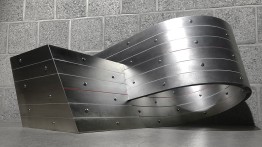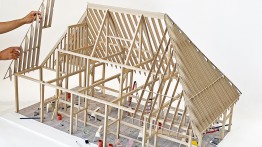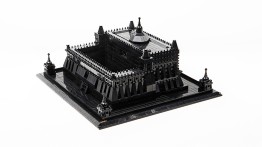New Exhibition Questions Impact of Architectural Models on Behavior
POSTED ON: September 28, 2022
Models, whether physical or digital, are intrinsic to architecture. Just as science, mathematics, politics, economics, and other fields use models to visualize, reflect, and predict behaviors, so do architectural models. Model Behavior, a group exhibition curated by the Anyone Corporation and presented by The Irwin S. Chanin School of Architecture, considers how architectural models contribute to shaping social behaviors. Running October 4 through November 18, 2022, in the colonnade and first floor of Cooper Union’s historic Foundation Building, Model Behavior features more than 70 works and objects by 45 artists and architects, including artists Olafur Eliasson, Isamu Noguchi, Ekow Nimako, and Thomas Demand and architects Peter Eisenman, Darell Wayne Fields, Greg Lynn, Forensic Architecture (Eyal Weizman), First Office (Anna Neimark and Andrew Atwood), MALL (Jennifer Bonner), Ensamble (Débora Mesa and Antón García-Abril), and Höweler + Yoon (Eric Höweler and Meejin Yoon), as well as School of Architecture graduates Stan Allen AR’81, David Gersten AR’91, Jürgen Mayer AR’91, Jesse Reiser AR’81, and Nanako Umemoto AR’83, and faculty member Michael Young.
“We are at a critical juncture, a time when we need to examine the models that have long been in use,” explains exhibition curator Cynthia Davidson. She is also editor of the independent architecture journal Log, which devoted its 50th issue to the many modes of architectural models, from structural to material, artistic to social. “As Thomas Demand has said, without models there would be chaos, but our current world models have led to the climate crisis, extreme poverty, and homelessness,” says Davidson. “We need to rewrite those models, especially now as architecture is questioning its methods and intentions.”
Featuring six installations commissioned specifically for the windows of The Cooper Union’s street level colonnade, as well as animated digital models, videos, photographs, renderings, and augmented reality, Model Behavior interrogates how architectural models elicit and project social behaviors. Objects on view represent a multitude of disciplines ranging from toys and scientific models to physical architectural models, such as a laser-cut plexiglass and paper model by Stan Allen for Frederic Church’s Olana and a bonded nickel World Trade Center from Constantin and Laurene Leon Boym’s Buildings of Disaster series. The windows, each set in a three-foot-deep niche, are treated like shop windows filled with dioramas and objects that are visible from the sidewalk. This installation site is another examination of how models prompt social behavior, as visitors may or may not choose to further explore the exhibition by entering the Foundation Building.
“Model making is central to all architectural education and practice, but our role as architects and educators is to consider the societal and environmental impact of design, and that starts with this foundational and iterative component of the design process,” says Hayley Eber, Acting Dean of The Irwin S. Chanin School of Architecture.
In tandem with the exhibition, the School of Architecture presents two public lectures in the Great Hall: art historian Annabel J. Wharton in conversation with Sylvia Lavin on October 10 and architect Kiel Moe in conversation with Sanford Kwinter on November 8.
New Affiliates designed the exhibition installation for Model Behavior. Generous support for Model Behavior has been provided by the Graham Foundation for Advanced Studies in the Fine Arts, New York State Council on the Arts, and Elise Jaffe + Jeffrey Brown.
This exhibition is presented in association with Archtober, Architecture and Design Month New York City, October 2022.







